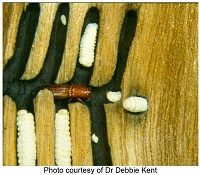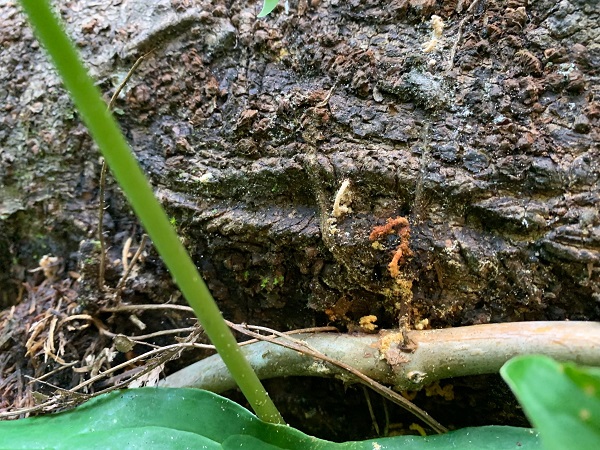Doctor James Bickerstaff
Candidature
Graduated PhD 2022
Thesis Title
The phylogeography and microbial ecology of Australian ambrosia beetle taxa (Curculionidae: Platypodinae and Scolytinae)
Research Project
 Ambrosia beetles (Curculionidae: Platypodinae and Scolytinae) are ecologically important and an interesting evolutionary guild of weevils. Recently it has been found that the two subfamilies are more distantly related than originally thought. Yet, they have convergently evolved similar life history strategies. Ambrosia beetles farm fungi as their sole source of nutrition on tunnel walls excavated in the heart- and sapwood of trees. Many species have highly social family structures with larvae and adults contributing to tunnel excavation. Maintaining gallery hygiene and attendance to the fungal gardens are important behavioural traits. Most ambrosia beetles develop in recently dead or dying trees, however, some species attack living healthy trees and are notorious forestry pests. A small number of ambrosia beetle species live in living trees without impacting tree health.
Ambrosia beetles (Curculionidae: Platypodinae and Scolytinae) are ecologically important and an interesting evolutionary guild of weevils. Recently it has been found that the two subfamilies are more distantly related than originally thought. Yet, they have convergently evolved similar life history strategies. Ambrosia beetles farm fungi as their sole source of nutrition on tunnel walls excavated in the heart- and sapwood of trees. Many species have highly social family structures with larvae and adults contributing to tunnel excavation. Maintaining gallery hygiene and attendance to the fungal gardens are important behavioural traits. Most ambrosia beetles develop in recently dead or dying trees, however, some species attack living healthy trees and are notorious forestry pests. A small number of ambrosia beetle species live in living trees without impacting tree health.
The Australian ambrosia beetle fauna has not been widely explored. Few studies have investigated their ecology, distribution, or natural history. Much of the focus has been on pest species, such as Platypus subgranosus that can transmit a pathogen of Nothofagus trees, or the world’s only eusocial beetle, Austroplatypus incompertus that establishes long lasting (up to 40 years) galleries in trees without impacting tree health. Little is known about the diversity of ambrosia beetles and their symbiotic fungi in Australia.
The biogeography and phylogeography of ambrosia beetles in combination with their symbiotic fungi has received limited research attention across the globe. Few studies have investigated the population structure of beetles and fungi. The Great Dividing Range of eastern Australia has many regions with mesic forest and relic Gondwanan rainforest ecosystems, and in the north, extensive wet tropical rainforests. These rainforest regions are divided by dry corridors that limit mesic faunal and floral exchange across these barriers. This project endeavours to describe the diversity of the ambrosia symbiosis across these regions and to examine the impact of geographic barriers.
The primary questions of this PhD are:
- What species of fungi are farmed by Australian ambrosia beetles?
- Is there evidence of co-evolution between ambrosia beetles and their fungi?
- How does the geography and topography of eastern Australia impact the biogeography and phylogeography of the ambrosia beetle and fungal symbiosis?
Research Images

Figure 1: Austroplatypus incompertus tending to the fungal garden and larvae within excavated tunnels in trees

Figure 2: Frass noodles and sawdust being ejected from tree as a result of ambrosia beetle boring activity
Publications
Bickerstaff JRM, Smith SS, Kent DS, Beaver RA, Seago AE, Riegler M, (2020) 'A review of the distribution and host plant associations of the platypodine ambrosia beetles (Coleoptera: Curculionidae: Platypodinae) of Australia, with an electronic species identification key', Zootaxa, vol.4894, no.1, pp 69-80
Thomson SA, Pyle RL, Ahyong ST, Alonso-Zarazaga M, Ammirati J, Araya JF, Ascher JS, Audisio TL, Azevedo-Santos VM, Bailly N, Baker WJ, Balke M, Barclay MVL, Barrett RL, Benine RC, Bickerstaff JRM, Bouchard P, Bour R, Bourgoin T, Boyko CB, Breure ASH, Brothers DJ, Byng JW, Campbell D, Ceríaco LMP, Cernák I, Cerretti P, Chang C-H, Cho S, Copus JM, Costello MJ, Cseh A, Csuzdi C, Culham A, D’Elía G, d’Acoz C, Daneliya ME, Dekker R, Dickinson EC, Dickinson TA, van Dijk PP, Dijkstra K-DB, Dima B, Dmitriev DA, Duistermaat L, Dumbacher JP, Eiserhardt WL, Ekrem T, Evenhuis NL, Faille A, Fernández-Triana JL, Fiesler E, Fishbein M, Fordham BG, Freitas AVL, Friol NR, Fritz U, Frøslev T, Funk VA, Gaimari SD, Garbino GST, Garraffoni ARS, Geml J, Gill AC, Gray A, Grazziotin FG, Greenslade P, Gutiérrez EE, Harvey MS, Hazevoet CJ, He K, He X, Helfer S, Helgen KM, van Heteren AH, Hita Garcia F, Holstein N, Horváth MK, Hovenkamp PH, Hwang WS, Hyvönen J, Islam MB, Iverson JB, Ivie MA, Jaafar Z, Jackson MD, Jayat JP, Johnson NF, Kaiser H, Klitgård BB, Knapp DG, Kojima J-I, Kõljalg U, Kontschán J, Krell F-T, Krisai-Greilhuber I, Kullander S, Latella L, Lattke JE, Lencioni V, Lewis GP, Lhano MG, Lujan NK, Luksenburg JA, Mariaux J, Marinho-Filho J, Marshall CJ, Mate JF, McDonough MM, Michel E, Miranda VFO, Mitroiu M-D, Molinari J, Monks S, Moore AJ, Moratelli R, Murányi D, Nakano T, Nikolaeva S, Noyes J, Ohl M, Oleas NH, Orrell T, Páll-Gergely B, Pape T, Papp V, Parenti LR, Patterson D, Pavlinov IY, Pine RH, Poczai P, Prado J, Prathapan D, Rabeler RK, Randall JE, Rheindt FE, Rhodin AGJ, Rodríguez SM, Rogers DC, Roque F deO, Rowe KC, Ruedas LA, Salazar-Bravo J, Salvador RB, Sangster G, Sarmiento CE, Schigel DS, Schmidt S, Schueler FW, Segers H, Snow N, Souza-Dias PGB, Stals R, Stenroos S, Stone RD, Sturm CF, Štys P, Teta P, Thomas DC, Timm RM, Tindall BJ, Todd JA, Triebel D, Valdecasas AG, Vizzini A, Vorontsova MS, de Vos JM, Wagner P, Watling L, Weakley A, Welter-Schultes F, Whitmore D, Wilding N, Will K, Williams J, Wilson K, Winston JE, Wüster W, Yanega D, Yeates DK, Zaher H, Zhang G, Zhang Z-Q, Zhou H-Z, (2018) 'Taxonomy based on science is necessary for global conservation', PLOS Biology, vol.16, no.3, e2005075
Grants
- Holsworth Wildlife Research Endowment, Ecological Society of Australia, 2018
- Student Travel Grant, ABRS National Taxonomy Research Grant Program, 2019
Supervisors
A/Professor Markus Riegler and A/Prof Bjarte Jordal, (University Museum of Bergen - Norway)